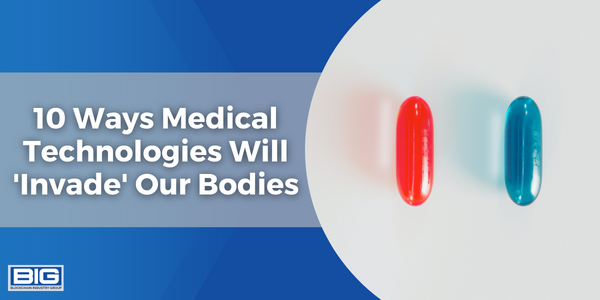
Future technologies will enable us to utilize or incorporate medical technology inside or on our bodies in a number of innovative ways. These include the use of nanobots to perform medical procedures, implantable devices that deliver medication or stimulate the nervous system, wearable medical devices that monitor health parameters, 3D-printed organs and tissues that can be used to replace or repair damaged body parts, and gene editing techniques that allow for the modification or repair of specific genes.
Other innovative approaches include brain-computer interfaces that allow us to communicate with computers or other devices using brain signals, exoskeletons that enhance the strength and mobility of the human body, artificial intelligence assistants that improve the accuracy and efficiency of medical diagnosis and treatment, smart contact lenses that can monitor health parameters and deliver medication, and personalized medicine approaches that are tailored to the individual needs and characteristics of the patient. These technologies have the potential to revolutionize healthcare and improve the quality of life for individuals.
- Nanobots: These are tiny robots that are capable of performing a variety of tasks, including delivering medication, repairing tissues and organs, and even detecting and removing cancer cells. By using nanobots, we can effectively target specific areas of the body and perform highly precise medical procedures.
- Implantable devices: These are devices that are surgically implanted into the body and are able to perform a variety of functions, such as monitoring vital signs, delivering medication, or stimulating the nervous system. Implantable devices can be used to treat a wide range of medical conditions and can provide a more convenient and effective way of delivering medical treatment.
- Wearable medical devices: These are devices that are worn on the body and are able to monitor and track various health parameters, such as heart rate, sleep patterns, and physical activity. Wearable medical devices can be used to help prevent and manage a wide range of health conditions, and they provide a convenient way for individuals to monitor their health on a continuous basis.
- 3D-printed organs and tissues: By using advanced 3D printing techniques, it is possible to create functional organs and tissues that can be used to replace or repair damaged or diseased body parts. This could potentially revolutionize organ transplantation and provide a new way of treating a variety of medical conditions.
- Gene editing: By using advanced gene editing techniques, it is possible to modify or repair specific genes in order to prevent or treat various health conditions. This could potentially lead to new treatments for a wide range of genetic disorders and provide a more targeted and effective way of addressing medical conditions.
- Brain-computer interfaces: Brain-computer interfaces (BCIs) are devices that allow us to communicate directly with computers or other devices using brain signals. By using BCIs, we can potentially control prosthetics, operate medical devices, or even control robots. BCIs have the potential to improve the quality of life for individuals with disabilities and provide a new way of interacting with technology.
- Exoskeletons: Exoskeletons are wearable devices that are designed to enhance the strength and mobility of the human body. By using exoskeletons, we can potentially improve physical rehabilitation, reduce the risk of injury, or even enhance physical performance. Exoskeletons have the potential to revolutionize healthcare and improve the quality of life for individuals with disabilities or mobility impairments.
- Artificial intelligence assistants: Artificial intelligence (AI) assistants are computer programs that are able to understand and respond to human input. By using AI assistants, we can potentially improve the accuracy and efficiency of medical diagnosis and treatment, or even provide personalized recommendations for healthcare. AI assistants have the potential to revolutionize healthcare and improve the quality of care for patients.
- Smart contact lenses: Smart contact lenses are contact lenses that are equipped with sensors, electronics, and other technologies that allow them to perform various functions. By using smart contact lenses, we can potentially monitor health parameters, deliver medication, or even enhance vision. Smart contact lenses have the potential to revolutionize healthcare and improve the quality of life for individuals with vision impairments or other health conditions.
- Personalized medicine: Personalized medicine is a approach to healthcare that is tailored to the individual needs and characteristics of the patient. By using personalized medicine, we can potentially improve the accuracy and effectiveness of medical treatment, reduce the risk of side effects, and improve the overall quality of care. Personalized medicine has the potential to revolutionize healthcare and provide a more personalized and effective approach to medical treatment.
20 Artificial Intelligence Use Cases
—
20 Autonomous Vehicle Use Cases
—
20 Internet of Things (IoT) Use Cases
In conclusion, advances in technology are constantly providing new and innovative ways for us to utilize or incorporate medical technology inside or on our bodies. From nanobots and implantable devices, to wearable medical devices and 3D-printed organs and tissues, there are many exciting developments that have the potential to revolutionize healthcare and improve our quality of life. These technologies provide new and improved methods for diagnosing and treating medical conditions, and they also offer the potential for more personalized and effective approaches to medical care. While these technologies are still in the early stages of development, they have the potential to significantly impact the future of healthcare and the way we approach medical treatment. Overall, these technologies offer a glimpse into the exciting possibilities that the future holds for healthcare and medical treatment.



